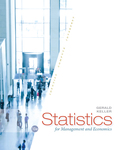
(a)
Derive the data.
(a)
Explanation of Solution
The null and alternative hypothesis can be written as follows:
Age Rejection region can be written as follows:
SST can be calculated as follows:
SSE can be calculated as follows:
Thus, the value of SSE is 12,752
Table -1 shows the ANOVA Table as follows:
|
Table -1 | ||||
| Source | Degree of freedom | Sum of square | Mean square | F |
| Treatments | k-1 = 36 | SST = 3,366 | 1,122 | 25.60 |
| Error | n- k = 291 | SSE = 12,752 | 43.82 | |
Thus, the estimated F- value is 25.6 and p-value is 0. Here, there is an adequate evidence to infer that the age of the four group of cereal buyers differ.
(b)
Explain the required conditions for the test conducted.
(b)
Explanation of Solution
The null and alternative hypothesis can be written as follows:
Income rejection region can be written as follows:
SST can be calculated as follows:
SSE can be calculated as follows:
Thus, the value of SSE is 13,256
Table -1 shows the ANOVA Table as follows:
| Table -2 | ||||
| Source | Degree of freedom | Sum of square | Mean square | F |
| Treatments | k-1 = 3 | SST = 1,008 | 336 | 7.37 |
| Error | n- k = 291 | SSE = 13,256 | 45.55 | |
Thus, the estimated F- value is 7.37 and p-value is 0.0001. Here, there is an adequate evidence to conclude that theincome differ between he four groups of cereal buyers.
(c)
Explain the required conditions for the test conducted.
(c)
Explanation of Solution
The null and alternative hypothesis can be written as follows:
Education rejection region can be written as follows:
SST can be calculated as follows:
SSE can be calculated as follows:
Thus, the value of SSE is 1,154
Table -1 shows the ANOVA Table as follows:
| Table -2 | ||||
| Source | Degree of freedom | Sum of square | Mean square | F |
| Treatments | k-1 = 3 | SST = 21.71 | 7.24 | 1.82 |
| Error | n- k = 291 | SSE = 1,154 | 3.697 | |
Thus, the estimated F- value is 1.82 and p-value is 0.1428. Here, there is not an adequate evidence to conclude that the educationdiffer between he four groups of cereal buyers.
(d)
Summarize the findings.
(d)
Explanation of Solution
Using F – tests and descriptive statistics, the mean age and the mean household income are in ascending order. Example, sweet smacks buyers are younger and earn less than the buyers of the other three cereals. Thus, individual ‘C’ purchases are older and earn the most.
Want to see more full solutions like this?
Chapter 14 Solutions
EBK STATISTICS FOR MANAGEMENT AND ECONO
- You are the manager of a large automobile dealership who wants to learn more about the effective- ness of various discounts offered to customers over the past 14 months. Following are the average negotiated prices for each month and the quantities sold of a basic model (adjusted for various options) over this period of time. 1. Graph this information on a scatter plot. Estimate the demand equation. What do the regression results indicate about the desirability of discounting the price? Explain. Month Price Quantity Jan. 12,500 15 Feb. 12,200 17 Mar. 11,900 16 Apr. 12,000 18 May 11,800 20 June 12,500 18 July 11,700 22 Aug. 12,100 15 Sept. 11,400 22 Oct. 11,400 25 Nov. 11,200 24 Dec. 11,000 30 Jan. 10,800 25 Feb. 10,000 28 2. What other factors besides price might be included in this equation? Do you foresee any difficulty in obtaining these additional data or incorporating them in the regression analysis?arrow_forwardsimple steps on how it should look like on excelarrow_forwardConsider options on a stock that does not pay dividends.The stock price is $100 per share, and the risk-free interest rate is 10%.Thestock moves randomly with u=1.25and d=1/u Use Excel to calculate the premium of a10-year call with a strike of $100.arrow_forward
- Please solve this, no words or explanations.arrow_forward17. Given that C=$700+0.8Y, I=$300, G=$600, what is Y if Y=C+I+G?arrow_forwardUse the Feynman technique throughout. Assume that you’re explaining the answer to someone who doesn’t know the topic at all. Write explanation in paragraphs and if you use currency use USD currency: 10. What is the mechanism or process that allows the expenditure multiplier to “work” in theKeynesian Cross Model? Explain and show both mathematically and graphically. What isthe underpinning assumption for the process to transpire?arrow_forward
- Use the Feynman technique throughout. Assume that you’reexplaining the answer to someone who doesn’t know the topic at all. Write it all in paragraphs: 2. Give an overview of the equation of exchange (EoE) as used by Classical Theory. Now,carefully explain each variable in the EoE. What is meant by the “quantity theory of money”and how is it different from or the same as the equation of exchange?arrow_forwardZbsbwhjw8272:shbwhahwh Zbsbwhjw8272:shbwhahwh Zbsbwhjw8272:shbwhahwhZbsbwhjw8272:shbwhahwhZbsbwhjw8272:shbwhahwharrow_forwardUse the Feynman technique throughout. Assume that you’re explaining the answer to someone who doesn’t know the topic at all:arrow_forward
 Managerial Economics: Applications, Strategies an...EconomicsISBN:9781305506381Author:James R. McGuigan, R. Charles Moyer, Frederick H.deB. HarrisPublisher:Cengage Learning
Managerial Economics: Applications, Strategies an...EconomicsISBN:9781305506381Author:James R. McGuigan, R. Charles Moyer, Frederick H.deB. HarrisPublisher:Cengage Learning Principles of Economics 2eEconomicsISBN:9781947172364Author:Steven A. Greenlaw; David ShapiroPublisher:OpenStax
Principles of Economics 2eEconomicsISBN:9781947172364Author:Steven A. Greenlaw; David ShapiroPublisher:OpenStax








